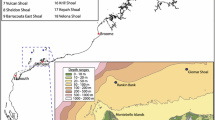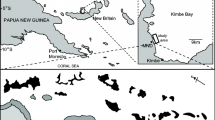Synopsis
Extensive limestone reefs are a characteristic feature of much of the coastline of Western Australia, and potentially represent a major habitat feature influencing the structure of the coastal fish community. The structure and temporal dynamics of the fish fauna and its relationships to nearshore patch reefs and surrounding habitat near Dongara, Western Australia, were examined using (1) diel gill-netting and (2) quantitative rotenone sampling of enclosed areas of substratum. Long-term and day-to-day variability of the fauna was low. Dominant species of gill-net collections were either associated with reefs or occurred in similar abundances at both reefs and surrounding sand/seagrass flats. The overall abundance, number of species and biomass of netted fishes was higher around reefs. Rotenone collections of the more sedentary species showed a similar pattern, but suggested, however, that a simple reef versus surrounding sand and seagrass habitat comparison is complicated by the canopy-forming seagrass Amphibolis that occurs on reef tops. Time of day had an important effect on overall fish abundance and number of species, with peaks occurring at crepuscular periods. This reflected dusk and dawn activity peaks of a dominant species rather than overlapping activities of many diurnal and nocturnal species. Diel switches between reef-edge habitat and surrounding sand/seagrass flats were uncommon despite expectations (based on literature examples) that patch reefs would function primarily as sheltering habitats and surrounding non-reef areas act as foraging habitat. High catches at reef-edge sites suggest that the majority of fishes forage on or near limestone patch reefs. Fish densities of around 0.8 individuals per m-2 of bottom on these Western Australian reefs are relatively high in comparison to visual census estimates obtained for temperate reef systems in South Australia and New Zealand, but similar to those obtained using comparable netting methods in temperate Australian seagrass systems.
Similar content being viewed by others
References cited
Ayling, A.M. 1978. Okakari Point to Cape Rodney marine reserve. A biological survey. University of Auckland Marine Laboratory, Auckland. 98 pp.
Bell, J.D. & M. Westoby. 1986. Importance of local change in leaf height and density to fish and decapods associated with seagrasses. J. Exp. Mar. Biol. Ecol. 104: 249–274.
Branden, K.L., G.J. Edgar & S.A. Shepherd. 1986. Reef fish populations of the Investigator Group, South Australia: a comparison of two census methods. Trans. R. Soc. S. Aust. 110: 69–76.
Burchmore, J.J., D.A. Pollard & J.D. Bell. 1984. Community structure and trophic relationships of the fish fauna of an estuarine Posidonia australis seagrass habitat in Port Hacking, New South Wales. Aquat. Bot. 18: 71–87.
Chittleborough, R.G. 1979. Natural regulation of the population of Panulirus longipes cygnus George and responses to fishing pressure. Rapp. P.-v. Reun. Cons. int. Explor. Mer. 175: 217–221.
Chittleborough, R.G. 1976. Growth of juvenile Panulirus longipes cygnus George on coastal reefs compared with those reared under optimal conditions. Aust. J. Mar. Freshwat. Res. 27: 279–295.
Chittleborough, R.G. & B.F. Phillips. 1975. Fluctuations of year-class strength and recruitment in the western rock lobster Panulirus longipes (Milne-Edwards). Aust. J. Mar. Freshwat. Res. 26: 317–328.
Cobb, J.S. 1981. Behaviour of the Western Australian spiny lobster, Panulirus cygnus George, in the field and laboratory. Aust. J. Mar. Freshwat. Res. 32: 399–409.
Collette, B.B. & F.H. Talbot. 1972. Activity patterns of coral reef fishes with emphasis on nocturnal-diurnal changeover Nat. Hist. Mus. Los Angeles County Bull. 14: 98–124.
Dybdahl, R.E. 1979. Technical report on fish productivity. Cockburn Sound study. Western Australian Department of Conservation and Environment, Report No. 4, Perth. 96 pp.
Hobson, E.S. 1965. Diurnal-nocturnal activity of some inshore fishes in the Gulf of California. Copeia 1965: 291–302.
Hobson, E.S. 1973. Diel feeding migrations of tropical reef fishes. Helgoländer wiss. Meeresunters. 24: 361–370.
Hutchins, B. & M. Thompson. 1983. The marine and estuarine fishes of south-western Australia. Western Australian Museum, Perth. 103 pp.
Joll, L.M. & B.F. Phillips. 1984. Natural diet and growth of juvenile western rock lobsters Panulirus cygnus George. J. Exp. Mar. Biol. Ecol. 75: 145–169.
Lasiak, T. 1984. Structural aspects of the surf-zone fish assemblage of King's Beach, Algoa Bay, South Africa: shortterm fluctuations. Est. Coast Shelf Sci. 18: 347–360.
Orth, R.J. & K.L. Heck, Jr. 1980. Structural components of the eelgrass (Zostera marina) meadows in the lower Chesapeake Bay — fishes. Estuaries 3: 278–288.
Phillips, B.F., L.M. Joll & D.C. Ramm. 1984. An electromagnetic tracting system for studying the movements of rock (spiny) lobsters. J. Exp. Mar. Biol. Ecol. 79: 9–18.
Robblee, M.B. & J.C. Zieman. 1984. Diel variation in the fish fauna of a tropical seagrass feeding ground. Bull. Mar. Sci. 34: 335–345.
Robertson, A.I. 1980. The structure and organization of an eelgrass fish fauna. Oecologia 47: 76–82.
Robertson, A.I. & R.C.J. Lenanton. 1984. Fish community structure and food chain dynamics in the surf-zone of sandy beaches: the role of detached macrophyte detritus. J. Exp. Mar. Biol. Ecol. 84: 265–283.
Russell, B.C. 1977. Population and standing crop estimates for rocky reef fishes of north-eastern New Zealand. N.Z. J. Mar. Freshwat. Res. 11: 23–36.
Stoner, A.W. 1983. Distribution of fishes in seagrass meadows: role of macrophyte biomass and species composition. U.S. Fish. Bull. 81: 837–846.
Author information
Authors and Affiliations
Rights and permissions
About this article
Cite this article
Howard, R.K. The structure of a nearshore fish community of Western Australia: diel patterns and the habitat role of limestone reefs. Environ Biol Fish 24, 93–104 (1989). https://doi.org/10.1007/BF00001280
Received:
Accepted:
Issue Date:
DOI: https://doi.org/10.1007/BF00001280




